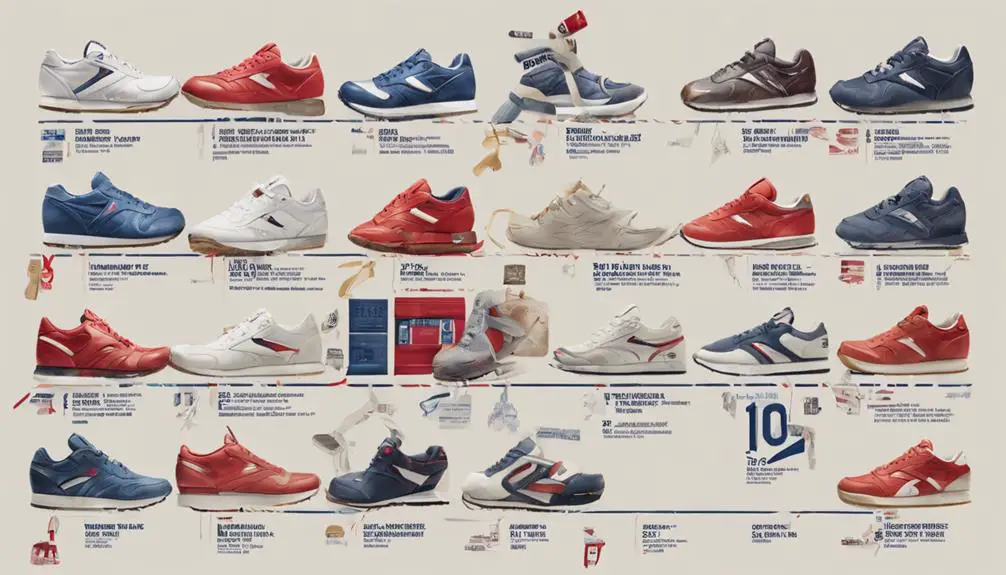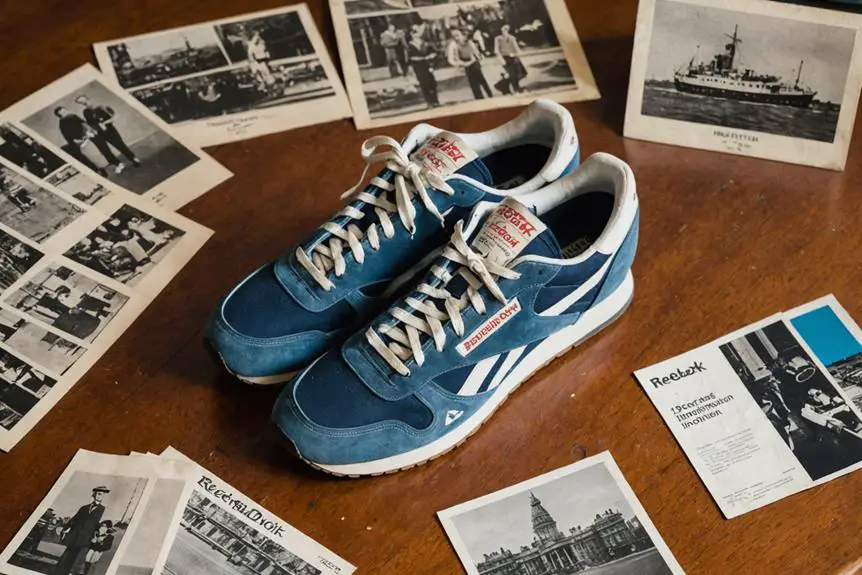Reebok was founded in 1958 by Jeff and Joe Foster in Bolton, England, carrying on a footwear tradition that began in 1895. Originally named J.W. Foster & Sons, the company focused on creating high-quality running shoes. In 1960, they rebranded as Reebok, inspired by the Afrikaans word for "rhebok," symbolizing agility. This change marked the start of its journey towards becoming a major player in sports footwear. Over the years, Reebok evolved considerably, introducing iconic products and innovative designs. If you want to explore more about its fascinating history and milestones, there's a lot more to uncover!
Early Foundations of Reebok

In 1958, Reebok was born out of the vision of Jeff and Joe Foster, who left their family's shoemaking legacy at J.W. Foster & Sons to create a new athletic footwear brand. This decision marked a pivotal moment in the evolution of sports shoes, as the Fosters sought to develop products that emphasized performance and agility.
The name "Reebok," derived from the Afrikaans spelling of the African antelope "rhebok," perfectly encapsulated this mission. The brand aimed to cater to a growing market that demanded both style and functionality in athletic wear, which was a significant departure from traditional sports shoes.
Prior to founding Reebok, the Foster family had already made a mark in the industry with their spiked running shoes, which gained popularity among athletes since the late 19th century. They built a solid reputation for quality and innovation in athletic footwear. When Jeff and Joe Foster ventured out on their own, they brought with them a wealth of experience from the family business, J.W. Foster & Sons.
Reebok's original logo featured the Union Jack flag, symbolizing the company's British heritage and humble beginnings. The brand's real breakthrough came in 1979 when it entered the U.S. market.
It quickly became a household name, especially known for the Reebok Freestyle, a shoe that targeted women during the aerobics boom of the early 1980s. This innovative approach to athletic footwear set Reebok apart from its competitors and laid the groundwork for its future success, with the evolution of Reebok's logo reflecting its growing influence in the industry.
The Birth of the Reebok Brand
The birth of the Reebok brand marked a significant shift in the athletic footwear industry. Founded in 1958 by brothers Jeff and Joe Foster in Bolton, England, Reebok emerged after they left their family business, J.W. Foster & Sons, which had a long-standing reputation for producing spiked running shoes. The name "Reebok" comes from the Afrikaans word for a type of antelope, "rhebok," symbolizing agility and speed—qualities that resonate with athleticism.
Initially, Reebok focused on producing high-quality athletic footwear, especially running shoes. As the fitness craze surged in the 1980s, the brand seized the opportunity to innovate, becoming a pioneer in women's athletic footwear with the launch of the Freestyle, the first athletic shoe designed specifically for women's aerobics. This groundbreaking move not only filled a gap in the market but also set the stage for Reebok to become a household name.
To build its reputation, Reebok employed clever marketing strategies, including endorsements from prominent athletes. These endorsements helped the brand gain visibility and credibility, making it a strong contender in the competitive athletic footwear market. The combination of style, comfort, and performance attracted a diverse audience, from serious runners to casual fitness enthusiasts.
As you look at Reebok today, you can see how its humble beginnings in Bolton evolved into a global brand that continues to influence the athletic footwear landscape. The journey of Jeff and Joe Foster laid the groundwork for a legacy that champions both innovation and a commitment to fitness.
Key Milestones in History

Reebok's journey is marked by several key milestones that shaped its identity and success in the athletic footwear industry. Founded in 1958 by Jeff and Joe Foster, Reebok emerged from their family's shoemaking business, J.W. Foster & Sons, which had a rich history dating back to 1895. Inspired by the Afrikaans word for an antelope, "rhebok," the brand aimed to carve out a unique space in the market, particularly by catering to the growing trend of fitness and aerobics pioneering innovations in footwear.
In 1982, Reebok made waves with the introduction of the Reebok Freestyle, targeting the women's aerobics market and quickly becoming a sensation. This launch was a critical turning point, boosting Reebok's visibility and sales. By 1979, Paul Fireman had acquired the U.S. licensing rights for Reebok, paving the way for rapid growth. In just two years, sales skyrocketed to $1.5 million by 1981, setting the stage for even greater success.
The brand continued to innovate, and in 1989, it launched the Reebok Pump, a revolutionary basketball shoe featuring adjustable fit technology. This was a game-changer in the athletic footwear world, further solidifying Reebok's reputation.
By 1986, the brand reached over $1 billion in sales, becoming a leader in the market.
These milestones reflect Reebok's evolution from a small family business to a powerhouse in athletic footwear, showcasing the vision of its founders and the strategic moves that propelled its growth. Each step in this journey contributed greatly to Reebok's lasting legacy in the industry.
Evolution of Products and Innovations
Evolving from its humble beginnings, Reebok has consistently pushed the boundaries of athletic footwear through innovative product development. Founded in 1958 by Joe and Jeff Foster, this brand emerged from a family shoemaking legacy in Bolton, England.
One of Reebok's standout innovations came in 1982 with the introduction of the Freestyle, a game-changer in the women's aerobics shoe market. By 1984, Freestyle shoes accounted for over half of Reebok's sales, establishing a strong foothold in fitness.
In 1989, Reebok revealed the Pump technology, an adjustable fit basketball shoe that allowed wearers to customize their comfort. This innovative design not only enhanced performance but also resonated with consumers looking for personalized footwear.
Fast forward to 2011, and you'll find the Reebok Nano, the first official CrossFit shoe. This release showcased Reebok's commitment to fitness and innovative product development, meeting the needs of the growing CrossFit community.
Further advancing their technological edge, Reebok introduced Z-Series foam technology in 2014, providing exceptional cushioning and durability in their running shoes. They also developed Liquid Factory technology, aiming to revolutionize shoe manufacturing processes.
Each of these innovations illustrates Reebok's dedication to enhancing athletic performance, whether it's through comfort, fit, or advanced technology. By continually evolving their products, Reebok remains a key player in the athletic footwear industry, appealing to athletes and fitness enthusiasts alike.
Reebok's Market Presence Today

In today's competitive landscape, Reebok stands as a resilient player in the athletic footwear market, showcasing a renewed commitment to its brand identity and strategic growth. After being sold to Authentic Brands Group for $2.5 billion in 2021, Reebok has shifted its focus back to its roots in fitness. This shift aims to capture market share and boost sales, directly competing with giants like Nike and Adidas.
Reebok's retail sales were projected to exceed $5 billion in 2022, thanks to its emphasis on innovative apparel and footwear designs. The brand isn't just about aesthetics; it's also prioritizing sustainability. By integrating eco-friendly practices into its operations, Reebok appeals to environmentally conscious consumers, making its products more attractive.
To strengthen its presence in the fitness-oriented market, Reebok is tapping into community-driven fitness events and partnerships with various fitness organizations. This approach mirrors the company's successful strategies in the 1980s, when it became a household name in athletic wear.
Additionally, Reebok is capitalizing on online sales channels, recognizing that digital shopping is key to reaching today's consumers. By enhancing its online presence, the brand can connect with a wider audience and streamline its sales process.





Wonderful goods from you, man. I’ve understand your stuff previous to and
you’re just too great. I really like what you’ve acquired here, really
like what you are saying and the way in which you say it.
You make it enjoyable and you still take care of to keep it wise.
I cant wait to read far more from you. This is actually a wonderful
website.
keep up the great piece of work, I read few articles on this web site and I conceive that your web blog is really interesting and has got circles of great info .